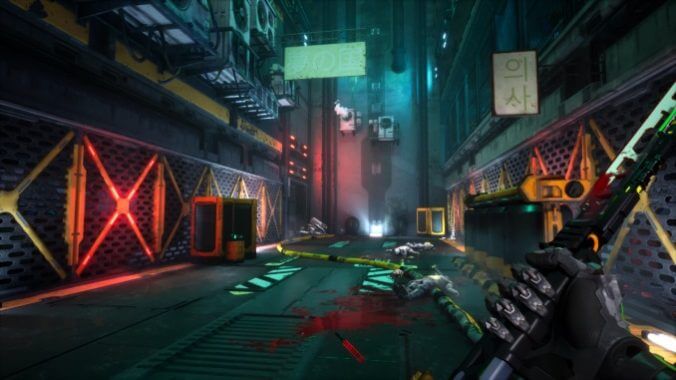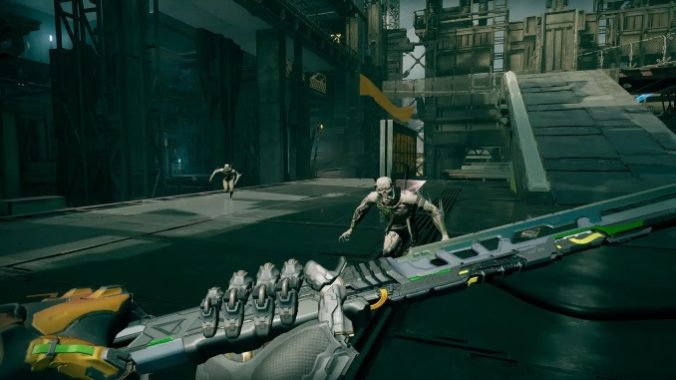
Coming in alongside a wave of twitchy, “one hit and you’re dead” style games, 2020’s Ghostrunner delivered smooth first-person parkour and smartly engineered scuffles set against a neon-lit skyline. Sure, it was relatively straightforward, as at any given moment, you were either slicing waves of goons in back alleys or puzzle solving in the Cybervoid, but these elements were cleanly executed and respected your time. It knew where its strengths lay, and instead of undercutting its blistering cadence with cutscenes, exposition was delivered via background conversations as you sped through this crumbling city.
After a relatively brief three-year wait, we have a follow-up in Ghostrunner 2, a sequel that trades the leanness of its predecessor for attempts at a more varied and comprehensive experience. While quite a few speed bumps hold it back from lapping the previous game, such as performance issues and bloat in its design, between its breakneck movement, elegant gauntlets, and smart expansions on this futuristic assassin’s toolset, it’s a follow-up that largely sticks the landing.
The general format is the same: you play as Jack the Ghostrunner, a killer cyborg who can end foes with a single slash of his impossibly sharp blade, but who also happens to have the constitution of wet tissue paper. Following in the footsteps of games like Hotline Miami, you have to choreograph your own single-take fight scene, mentally mapping out the nuances of each interaction to compensate for only having a single hit point.
These brawls remain the digitized soul of this experience, combining fast-paced platforming with honed swordplay. It’s all about closing the distance between your adversaries so you can cut them down to size, and to accomplish this, you can wall run on conveniently placed billboards, utilize a forward dash, briefly slow down time to dodge incoming plasma, and block or parry incoming blows. A successful run through an arena is over quickly, but stringing together the correct sequence of jumps, ripostes, dodges, and slashes almost always takes myriad attempts, which are made far more bearable thanks to frequent checkpoints and quick reload speeds.
Ghostrunner 2 delivers on its tough but fair design ethos in large part because its platforming feels appropriately agile. Jack barrels through his surroundings, and between responsive movement and the ability to temporarily slow down time and take stock of the battlefield, you’re given the tools to overcome being outnumbered. Although consistently challenging, another reason these fights feel well-tuned is that there are almost always multiple paths through an area that allow you to funnel enemies and mitigate your frailty. And even as I wished there were a larger number of fresh baddies, their quirks ensure that each section adopts unique tempos as I slide under guillotine-like laser blasts, parry swords, and redirect incoming projectiles. Similarly, trapezing through this dystopian playground requires rapidly cycling between movement techniques to overcome disparate obstacles in satisfying strings of parkour.
And although these types of scrambly, deep-focus inducing brawls were very much present in the previous game, the biggest change to this sequel’s action is that despite remaining a glass cannon, Jack feels even more like a cybergod. Abilities that used to be temporary power-ups, such as the shuriken, are now core weapons in your arsenal, letting you pick off peskier foes from afar. You can become invisible and leave a decoy to pounce on a back line or use Tempest to push a group of charging brawlers off a skyscraper. And then there are the Ultimate abilities, which let you hack brains, fire laser beams from your palms, and more. Of course, these techniques don’t come for free, and they either use Energy or your Ultimate meter, which both recharge with time, but it feels like every challenge has myriad solutions and that my specific bloody path was only scratching the surface.
There’s also a new upgrade system that lets you purchase chips, which offer anything from passive changes, such as decreasing how much stamina it costs to dash, to massive buffs that borderline break the rules of the game, like gaining a shield that tanks a hit when you reach a certain combo threshold. These traits can be mixed and matched and have additional requirements that activate based on how they’re placed in the motherboard, which all combine to grant surprisingly engaging decision-making. There may be a greater density of murderous metallic foes in your way this time around, but these new tools even the odds.

However, as previously mentioned, beyond just building on its central tenets, Ghostrunner 2 also attempts to expand past its core appeal. Its most successful crack at this is how it encourages exploration by sprinkling upgrade chips throughout the world. While this could have easily tortured my upgrade-obsessed psyche and caused me to waste time bumbling around, a mini-map mercifully informs when one is nearby, ensuring this process wasn’t a tedious pixel hunt and was more about cracking fun little environmental puzzles.
Unfortunately, most other ways it tries to mix things up aren’t as fruitful. For instance, after gaining a motorcycle, there are a few decent setpieces where you frantically weave between obstacles at a blinding pace, but your wheels are eventually repurposed for exploring the post-apocalyptic wastes outside Dharma City. These dull stretches stymy the electric pacing found elsewhere, resulting in long gaps where Jack can’t test his mettle. Even when battles pop up in these areas, they’re missing the tight level design found earlier, resulting in skirmishes that don’t feel as tense. Although looking back at my capture footage, this sequence only makes up roughly two-ish of the 10-12 hour runtime, it feels much longer due to segments where navigating these dusty roads is about as fun as missing an exit on the highway.
Another notable change compared to its predecessor is that in between levels, you’re whisked back to the Climber’s base so you can chat with your allies. These interludes hit the breaks on the elements that I wanted to be engaging with, and while most of these conversations are optional, if you’re like me and hold out to the hope that the next bit of incidental dialogue may hold the elusive thematic key to the whole work, then you won’t be able to resist. It’s not that the writing is flat-out awful (although some of the performances are a little shaky), but the handful of actually noteworthy chats, such as discourse on transhumanism or the agency of artificially created people, happen over the radio in the middle of fights instead of when you’re at the HQ.
The game also fails to justify its slightly increased focus on storytelling because this world doesn’t feel particularly unique or specific. Its cyberpunk aesthetics are an amalgamation of references to more interesting works, and it falls into the same tiresome Orientalist tropes that inundate the genre. Between its videogame-y level design and the fact that you barely see this world’s inhabitants outside of chromed-out criminals who want to kill you, the backdrop feels like a thin veneer rather than a living, breathing space. The overarching plot, which centers on a group of proto-Ghostrunners attempting to topple the status quo, has a few highlights, such as some killer character designs and a member of the clique who questions the group’s methods, but the main villain didn’t pique my interest, and I can already feel the main plot points fading out of memory. It’s not that I expected this narrative to rival Neuromancer’s depiction of winding corporate spires fracturing the human spirit into a million byte-sized pieces or something, but the setting does very little to keep me invested. Some of this fatigue is a general symptom of there being so many other works that regurgitate these visual hallmarks, but in this specific case, these elements do little to bolster my engagement with the aspects of the experience I do care about (the slicing dudes part).
Unfortunately, there’s another flaw that broke my connection to the otherwise silky-smooth combat: performance issues. Despite my specs dramatically exceeding the recommended system requirements, I frequently ran into sizable frame drops during larger-scale conflicts, problems that persisted even after I lowered the settings and used DLSS in high-performance mode. I’m not sure if it runs better on consoles, but at least personally, the hyper-quick first-person movement here is something that I’d want to play with a mouse and keyboard. These moments weren’t constant but were frequent enough to drag down the otherwise crisp gameplay.
Although Ghostrunner 2’s attempts at expanding its setting fell flat, and I wish it ran better, its central action feels sharp thanks to its empowering movement abilities, extensive offensive tools, and pulverizing but generally well-designed enemy encounters. Most of these thrilling sequences require acrobatics that had me frantically switching between maneuvers as I narrowly avoided bullets and blades. While it has some weak stretches, and its cyberpunk narrative doesn’t offer much to the canon, its frenetic platforming was enough to keep me plugging back in.
Ghostrunner 2 was developed by One More Level and published by 505 Games. Our review is based on the PC version. It is also available on PlayStation and Xbox.
Elijah Gonzalez is an assistant TV Editor for Paste Magazine. In addition to watching the latest on the small screen, he also loves videogames, film, and creating large lists of media he’ll probably never actually get to. You can follow him on Twitter @eli_gonzalez11.